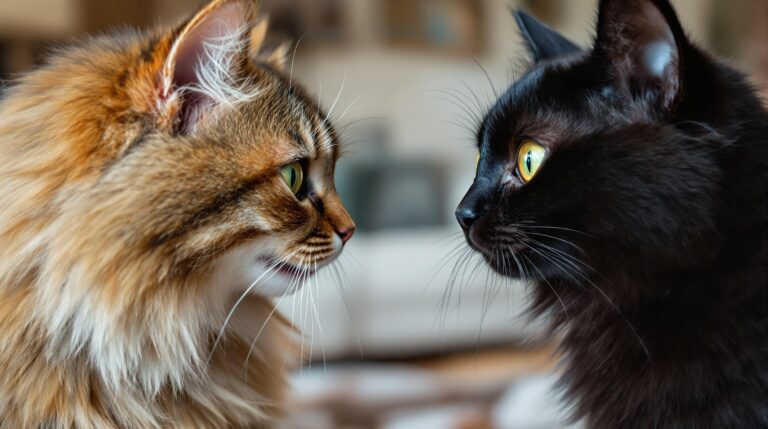The cats rabies vaccine is a crucial component of responsible pet ownership, ensuring the health and safety of your feline companion. This article will guide you through the importance of the vaccine, the vaccination process, and the steps you can take to protect your cat from rabies. By the end, you’ll have a comprehensive understanding of why the cats rabies vaccine is essential and how to keep your pet healthy.
Why the Cats Rabies Vaccine is Important
Preventing a Deadly Disease
Rabies is a viral disease that affects the central nervous system of mammals, including cats. Once symptoms appear, the disease is almost always fatal. The cats rabies vaccine is the most effective way to prevent your cat from contracting this deadly disease. By getting your cat vaccinated, you not only protect your pet but also help prevent the spread of rabies to other animals and humans.
The virus is transmitted through the saliva of infected animals, usually via bites. Cats that go outdoors are at a higher risk of exposure to rabies, especially if they come into contact with wild animals like raccoons, skunks, and bats. Vaccinating your cat is a simple and effective way to ensure their safety.
Legal Requirements and Compliance
In many regions, the cats rabies vaccine is required by law. These laws are in place to protect public health and reduce the risk of rabies transmission. Non-compliance can result in fines and other legal consequences. It’s important to check the specific requirements in your area and ensure that your cat is up to date with their vaccinations.
Local health departments and veterinary clinics can provide information on the legal requirements for cat rabies vaccination. They can also help you understand the consequences of non-compliance and the steps you need to take to stay in compliance. If you have any questions, feel free to contact us at info@catkarmacreations.com or visit our website at Cat Karma Creations.
Protecting Public Health
Vaccinating your cat against rabies is not just about protecting your pet; it’s also about protecting public health. Rabies can be transmitted from animals to humans, and an unvaccinated cat can pose a risk to the community. By ensuring your cat is vaccinated, you help create a safer environment for everyone.
Cats that are not vaccinated and come into contact with rabies can become carriers of the virus, potentially spreading it to other animals and humans. This can lead to outbreaks of the disease, which can be costly and difficult to control. Vaccination is a proactive measure that helps prevent these situations from occurring.
The Cats Rabies Vaccination Process
Types of Rabies Vaccines for Cats
There are several types of rabies vaccines available for cats, including inactivated (killed) and recombinant vaccines. Inactivated vaccines contain viruses that have been killed and are considered very safe. Recombinant vaccines, on the other hand, use genetic engineering to create a vaccine that stimulates an immune response without the risk of the virus causing the disease.
Your veterinarian can recommend the best type of vaccine based on your cat’s age, health, and lifestyle. It’s important to follow their advice and ensure that your cat receives the appropriate vaccine for their needs. If you need more information, you can reach out to us at (800) 343-1604 or visit our All Jewelry page for some inspiration.
Administration and Side Effects
The cats rabies vaccine is typically administered by injection, usually in the hind leg. The vaccination process is quick and relatively painless, and most cats tolerate it well. However, like any medical procedure, there can be side effects.
Common side effects of the cats rabies vaccine include swelling at the injection site, mild fever, and lethargy. These side effects are usually temporary and resolve on their own within a few days. In rare cases, more serious side effects such as allergic reactions can occur. If you notice any unusual symptoms in your cat after vaccination, contact your veterinarian immediately.
Vaccination Schedule and Boosters
The cats rabies vaccine is typically given to kittens as part of their initial vaccination series. The first dose is usually administered when the kitten is around 12 weeks old, followed by a booster shot one year later. After that, the frequency of booster shots may vary depending on the type of vaccine and the regulations in your area.
Some regions require annual booster shots, while others allow for a three-year interval between vaccinations. It’s important to follow the recommended schedule and keep track of your cat’s vaccination history. Your veterinarian can provide a vaccination record and remind you when it’s time for the next booster. For more information on our cat-themed jewelry, visit our Cat Themed Jewelry page.
Recognizing and Managing Rabies in Cats
Common Symptoms of Rabies in Cats
Early recognition of rabies symptoms is crucial for effective management. Some common signs of rabies in cats include aggression, paralysis, excessive drooling, and difficulty walking. These symptoms can appear suddenly and may worsen rapidly.
Other symptoms to watch for include changes in behavior, such as increased restlessness or irritability, and sensitivity to light and sound. If you notice any of these signs in your cat, it’s important to seek veterinary care immediately. Rabies is a medical emergency, and early intervention can improve the chances of a positive outcome.
What to Do if You Suspect Rabies
If you suspect that your cat has been exposed to rabies or is showing symptoms of the disease, it’s important to act quickly. The first step is to isolate your cat to prevent the virus from spreading to other animals or humans. Contact your veterinarian immediately and provide them with detailed information about your cat’s symptoms and any potential exposure to rabies.
Your veterinarian may recommend post-exposure prophylaxis, which involves a series of rabies vaccinations and, in some cases, antiviral medications. While there is no cure for rabies once symptoms appear, prompt treatment can help manage the disease and reduce the risk of transmission. If you have any concerns, you can reach out to us at sales@catkarmacreations.com or visit our Nature Inspired page for more information.
Treatment and Prevention Strategies
The primary treatment for rabies in cats is post-exposure prophylaxis, which involves a series of rabies vaccinations and, in some cases, antiviral medications. This treatment is most effective when administered as soon as possible after exposure to the virus. However, it’s important to note that once symptoms of rabies appear, the disease is almost always fatal.
Prevention is the best strategy for managing rabies in cats. Regular vaccination, avoiding exposure to wildlife, and creating a safe environment for your cat are all important steps in preventing the disease. Additionally, regular veterinary check-ups can help detect any health issues early and ensure that your cat remains healthy and protected. For more tips on cat care and wellness, follow us on Facebook and Instagram.
Creating a Safe Environment for Your Cat
Avoiding Exposure to Wildlife
One of the best ways to protect your cat from rabies is to minimize their exposure to wildlife. This can be challenging for outdoor cats, but there are steps you can take to reduce the risk. Keep your cat indoors as much as possible, especially during times when wild animals are most active, such as dawn and dusk.
If you allow your cat to go outside, supervise them closely and consider using a secure outdoor enclosure. This can provide a safe space for your cat to enjoy the outdoors while minimizing the risk of encountering wild animals. For more ideas on creating a safe environment, check out our Sterling Silver collection.
Indoor Living and Supervised Outdoor Time
Indoor living is the safest option for cats, as it significantly reduces the risk of exposure to rabies and other diseases. However, if you want to give your cat some outdoor time, supervised visits can be a good compromise. Use a harness and leash to control your cat’s movements and keep them away from areas where wild animals may be present.
Provide enrichment activities for your indoor cat to keep them mentally and physically stimulated. Toys, scratching posts, and interactive playtime can help keep your cat happy and healthy while reducing the urge to go outside. For more inspiration, visit our Stylish Cat Lover Necklaces page.
Regular Veterinary Check-Ups
Regular veterinary check-ups are essential for maintaining your cat’s health and preventing diseases like rabies. Your veterinarian can provide a comprehensive health assessment, including vaccinations, parasite control, and other preventive care. They can also answer any questions you may have about your cat’s health and provide guidance on how to keep your pet safe and healthy.
During these check-ups, your veterinarian can also monitor your cat for any signs of illness and provide early treatment if necessary. Regular check-ups are an important part of responsible pet ownership and can help ensure that your cat lives a long and healthy life. For more information on our cat-themed gifts, visit our Elegant Cat Brooch page.
Popular Quote
“The greatest wealth is health.” – Virgil
This quote emphasizes the importance of taking care of our health, including that of our pets. Just as we prioritize our own health, we must also prioritize the health and safety of our feline friends.
Statistical Fact
According to the World Health Organization (WHO), rabies is responsible for an estimated 59,000 human deaths annually, with 99% of these cases transmitted by dogs. While cats are not the primary carriers, they can still pose a risk, especially if they are not vaccinated. This statistic underscores the importance of vaccinating your cat to protect both your pet and the community.
Three Tips for Protecting Your Cat from Rabies
- Regular Vaccinations: Ensure your cat is up to date with their rabies vaccinations. Follow the recommended schedule and keep a vaccination record.
- Minimize Exposure to Wildlife: Keep your cat indoors or in a secure outdoor enclosure to reduce the risk of encountering wild animals that may carry the rabies virus.
- Regular Veterinary Check-Ups: Schedule regular check-ups with your veterinarian to monitor your cat’s health and ensure they receive all necessary preventive care.
Popular Questions
- Q: How often should I vaccinate my cat against rabies?
A: The frequency of rabies vaccinations can vary depending on the type of vaccine and local regulations. Generally, kittens receive their first dose at 12 weeks, followed by a booster one year later. After that, the interval may be annual or every three years. Consult your veterinarian for the recommended schedule in your area. - Q: Can indoor cats get rabies?
A: While indoor cats are at a lower risk, they can still contract rabies if exposed to an infected animal. It’s important to keep your indoor cat vaccinated to ensure they are protected. - Q: What should I do if my cat is bitten by another animal?
A: If your cat is bitten, seek veterinary care immediately. The vet may recommend a rabies booster and other treatments to prevent infection. Additionally, report the incident to local health authorities if required by law.
Final Thoughts About cats rabies vaccine
The cats rabies vaccine is a vital part of keeping your feline friend healthy and safe. By understanding the importance of the vaccine, following the recommended vaccination schedule, and creating a safe environment, you can protect your cat from the dangers of rabies. Visit our website to explore our range of cat-themed jewelry and gifts, and follow us on social media for more tips on cat care and wellness. If you have any questions or need assistance, don’t hesitate to contact us at admin@catkarmacreations.com or call us at (800) 343-1604.
| Feature | Cat Rabies Vaccine | Dog Rabies Vaccine | Human Rabies Vaccine |
|---|---|---|---|
| Purpose | Prevents rabies in cats | Prevents rabies in dogs | Prevents rabies in humans |
| Administration | Injection by a veterinarian | Injection by a veterinarian | Injection by a healthcare provider |
| Frequency | Annual or every 3 years | Annual or every 3 years | Pre-exposure: 3 doses over 28 days, Post-exposure: 4 doses |
| Side Effects | Swelling, fever, allergic reactions | Swelling, fever, allergic reactions | Pain, redness, headache, nausea |
| Legal Requirements | Required by law in many regions | Required by law in many regions | Recommended for high-risk individuals, required for travel to certain countries |
- Understand the importance of regular vaccinations to protect your cat from rabies.
- Learn about the different types of rabies vaccines available for cats and their effectiveness.
- Explore the legal requirements for cat rabies vaccination in your area and the consequences of non-compliance.
- Discover the common side effects of the cat rabies vaccine and how to manage them.
- Find out how to recognize the symptoms of rabies in cats and what to do if you suspect an infection.
- Get tips on creating a safe environment for your cat to minimize the risk of rabies exposure.
















